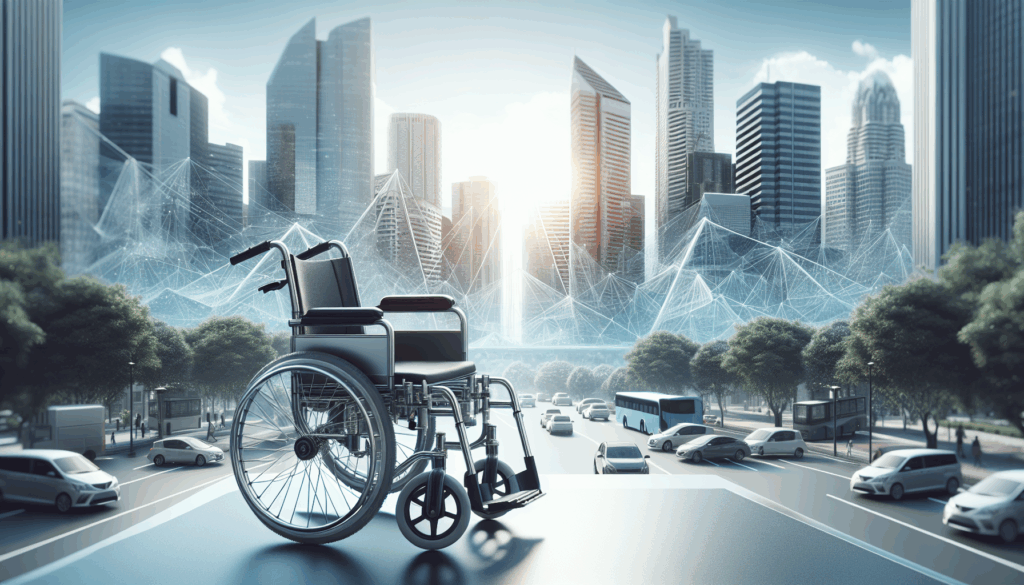
As we stand on the brink of a revolutionary shift in mobility assistance, electric wheelchairs are emerging as vital tools for enhancing independence and quality of life for many individuals. Whether due to age, disability, or temporary injury, the need for effective mobility solutions is more pertinent than ever. However, the evolution of electric wheelchairs comes with its own set of pros and cons that potential users must consider, including factors such as cost, accessibility, and reliability. Additionally, as cities strive to become more inclusive, it is crucial for urban planners and communities to evaluate the amenities that enhance the mobility experience for e-wheelchair users, ensuring that they can navigate their environments safely and comfortably.
Who Needs an Electric Wheelchair?
As cities strive for inclusivity, understanding who needs electric wheelchairs is imperative for designing accessible public spaces. This includes creating ramps, widening doorways, and ensuring that public transportation systems are equipped to accommodate all users. By considering these needs, cities can better support the growing population that relies on electric mobility solutions, fostering a more inclusive and accessible future for everyone.
Understanding the Varied Use Cases for Electric Wheelchairs
E-wheelchair are essential mobility aids for many individuals, particularly those with limited physical capabilities due to conditions such as spinal cord injuries, muscular dystrophy, or neurological disorders. They empower users to achieve greater independence, facilitating ease of movement in both indoor and outdoor settings. Knowing who needs an e-wheelchair helps guide the development and functionality of these devices, ensuring they meet the needs of a diverse demographic seeking freedom and mobility in their daily lives.
However, as we consider the varied use cases for e-wheelchair, it’s important to weigh the pros and cons. While these devices offer incredible benefits such as enhanced mobility, comfort, and accessibility, they can also present challenges such as maintenance costs and the need for compatible infrastructure. To fully support e-wheelchair users, cities must prioritize amenities like accessible ramps, designated parking spaces, and smooth pavement surfaces. By creating an inclusive environment, we can ensure that individuals using e-wheelchairs are equipped to navigate their communities effectively and safely, ultimately fostering an era of increased mobility and independence for all.
Pros and Cons of Electric Wheelchairs: A Comprehensive Overview
Electric wheelchairs offer a transformative mobility solution for individuals with limited mobility, enhancing their independence and quality of life. The primary advantage of e-wheelchairs lies in their powered assistance, allowing users to navigate various terrains with ease, without the physical strain that manual wheelchairs can impose. Furthermore, modern designs often come equipped with advanced technology, such as customizable seating, built-in navigation systems, and even smartphone compatibility, making them a compelling choice for many. However, some downsides include the initial cost, which can be substantial, and the need for regular maintenance.
Additionally, weight and the complexity of certain models can present challenges in transportation and maneuverability in tight spaces. On a broader scale, the presence of e-wheelchair users in urban environments prompts cities to rethink their infrastructure. Accessibility becomes a crucial factor; thus, cities must ensure that public spaces are equipped with adequate ramps, wider doorways, and user-friendly public transportation options. Challenges like uneven sidewalks and insufficient parking can impede mobility, necessitating an overall commitment to creating an inclusive society. By addressing these concerns and optimizing urban spaces for e-wheelchair users, cities can facilitate a more accessible future, thereby enhancing the lives of many individuals who rely on these innovative mobility devices.
Technological Innovations in Electric Wheelchairs
Recent technological innovations in electric wheelchairs have significantly transformed mobility for those in need, enhancing independence and accessibility. These advanced wheelchairs are designed for various users, including individuals with mobility impairments, seniors, and people recovering from injuries. Innovations such as smart technology integration allow for easier navigation and personalized controls, while lightweight materials provide improved maneuverability.
Additionally, features like obstacle detection and automatic braking enhance safety, allowing users to gain confidence in their journeys. The continued advancement in battery technology also means longer-lasting power and quicker charging times, ultimately improving the user experience. As cities become more aware of the need for inclusivity, they must adapt to accommodate electric wheelchair users effectively. This includes creating accessible public spaces, such as parks and transportation systems equipped with ramps, elevators, and compliant parallel parking zones.
Additionally, rest areas that offer charging stations for electric wheelchairs can enhance the mobility experience, allowing users to travel further without concerns of losing power. Implementing these amenities not only benefits individuals using electric wheelchairs but also promotes a more inclusive society, fostering an environment where everyone can easily access and navigate their communities seamlessly.

What Amenities Should Cities Have to Accommodate Electric Wheelchair Users?
To create an inclusive and accessible environment for electric wheelchair users, cities must prioritize specific amenities that cater to their needs. Firstly, the installation of curb cuts and ramps at intersections is essential for easing movement and ensuring safety. Adequate-width sidewalks, designed to accommodate electric wheelchairs, are vital, as well as tactile paving for visually impaired users. Public transportation systems should be equipped with accessible vehicles, while bus and train stations should have elevators and designated waiting areas. These features not only support mobility but also help integrate electric wheelchair users into everyday city life.
In addition to transportation-related amenities, cities should consider accessible public restrooms and recreational spaces. Parks and community centers equipped with adapted facilities enable electric wheelchair users to enjoy leisurely activities without barriers. Furthermore, community events should implement accessible seating and viewing options, fostering inclusivity for all. By investing in these critical amenities, cities can enhance the quality of life for electric wheelchair users, empowering their independence and participation in social and cultural activities throughout the community.
The Role of Policy in Enhancing Electric Wheelchair Accessibility
The role of policy is pivotal in enhancing electric wheelchair accessibility, as it directly impacts the quality of life for individuals who rely on these mobility aids. Electric wheelchairs are crucial for people with limited mobility, including the elderly, those with disabilities, and individuals recovering from surgery or injury. Effective policies can ensure that public spaces, housing, and transportation systems are designed to accommodate the needs of electric wheelchair users, allowing them greater independence and mobility. Governments can implement regulations that mandate accessible infrastructure, making it easier for users to navigate their communities without barriers.
Moreover, to further support electric wheelchair users, policies must also address the availability of resources such as funding for electric wheelchair programs and grants for upgrading city amenities. Cities should prioritize the inclusion of accessible ramps, public transport options, and smooth, wide pathways to facilitate ease of movement. Encouraging local businesses to adopt accessibility measures will also help create an inclusive environment. By focusing on policy changes aimed at enhancing these facilities, we can build a future where electric wheelchair users experience seamless mobility and full participation in community life.
User Experience: Real Stories from Electric Wheelchair Users
The user experience of electric wheelchair users is a testament to the profound impact these devices have on enhancing mobility and independence. Many individuals who require electric wheelchairs face challenges such as mobility limitations, chronic conditions, or recovery from injuries. For these users, electric wheelchairs provide not only a means of transportation but also a pathway to reclaiming their autonomy, enabling them to participate more fully in social activities and daily tasks. Stories abound of users who have experienced a newfound sense of freedom, whether it’s navigating the local park, accessing public spaces, or simply enjoying a leisurely stroll with friends and family.
However, while electric wheelchairs can dramatically enhance quality of life, they come with their own set of pros and cons. Users often praise the convenience and technology integration of modern electric wheelchairs, such as battery longevity and customizable features. Yet, they may also face accessibility issues, particularly in areas lacking adequate infrastructure. Cities must invest in ramps, accessible sidewalks, and appropriate parking spaces to accommodate electric wheelchair users, as these improvements foster a more inclusive environment. Ultimately, hearing real stories and experiences from electric wheelchair users sheds light on what it means to navigate everyday life, offering valuable insights into how we can shape the future for better accessibility and comfort.
Future Trends in Electric Wheelchair Design and Functionality
The future of electric wheelchair design and functionality is increasingly centered around user needs and technological advancements. As more people who have mobility challenges look toward electric wheelchairs as a viable option for independence, manufacturers are responding by integrating innovative features. For instance, the development of lightweight materials and advanced batteries promises to enhance portability and battery life, while smart technology allows for real-time health monitoring and navigation assistance. These improvements are particularly valuable for individuals with disabilities, elderly individuals, or those recovering from injuries, providing them with not just mobility, but a personalized experience that caters to their specific requirements.
Moreover, cities are beginning to recognize the importance of accommodating electric wheelchair users through thoughtful urban planning and adequate amenities. Future designs will likely focus on ensuring that public spaces are accessible, with features such as wider sidewalks, ramps, and easily navigable public transport options. The integration of technology such as app-based navigation can guide users to the most accessible routes. This holistic approach to electric wheelchair design — emphasizing user-centric functionality and urban accessibility — will be pivotal in shaping a more inclusive environment for all.

Embracing a New Era of Mobility
As we continue to shape the future of electric wheelchairs, it’s essential to recognize the diverse needs of individuals who rely on these innovative mobility devices. From those with limited mobility to the elderly, electric wheelchairs provide critical support in maintaining independence and enhancing quality of life. While discussing the pros and cons, it’s evident that these devices offer unparalleled convenience and mobility, though challenges such as cost and accessibility still exist. Understanding who needs electric wheelchairs can guide future innovations and improvements in design.
Moreover, as we envision a future where electric wheelchairs become a standard mode of mobility, cities must adapt to accommodate these users. Implementing amenities such as accessible ramps, dedicated parking spaces, and wider sidewalks will foster inclusivity, allowing electric wheelchair users to navigate urban environments with ease. Together, by addressing the needs of this community and advocating for better infrastructure, we can create a society that not only supports mobility but also embraces diversity and fosters independence for all individuals.

I totally agree that electric wheelchairs bring about a huge change in people’s lives. It’s heartening to see that the author emphasizes the need for accessible infrastructure, which can greatly improve the user experience.
We’re glad you share the same enthusiasm for accessible infrastructure, Ariel! At Eko Life Malaysia, we’re committed to empowering mobility and independence for all, which is why we prioritize product quality, professional servicing, and inclusive community building. If you have any questions about our electric wheelchairs or need assistance with accessibility infrastructure, feel free to reach out to us at [email protected] or +60 3-7890 3042.
I’m glad the author highlights the importance of policy and inclusive urban planning in making cities more wheelchair accessible. This is a crucial aspect of promoting equal access to public spaces for people with disabilities.
Thank you for sharing your thoughts, Kai Jia. We completely agree with you on the importance of policy and inclusive urban planning in creating more wheelchair accessible cities. At Eko Life Malaysia, we believe that equal access to public spaces is a fundamental right for everyone, regardless of their abilities. If you’d like to learn more about our initiatives and how we’re working towards creating a more accessible and inclusive urban environment, please don’t hesitate to contact us via [email protected] or +60 3-7890 3042. We’d be more than happy to hear from you and discuss further.
I’m excited to see the future of electric wheelchairs unfold! With the rise of smart technology, I’m sure we’ll see more user-friendly and accessible designs emerge, greatly improving the lives of those who rely on them.
Hi Julian, we’re thrilled to hear that you’re excited about the future of electric wheelchairs! At Eko Life Malaysia, we’re committed to providing innovative and accessible products that empower individuals with mobility challenges. We wholeheartedly agree that advancements in smart technology will play a significant role in improving wheelchairs’ user-friendliness and accessibility. We’d be delighted to discuss more about our products and services, including our range of electric wheelchairs designed with user needs in mind. Please don’t hesitate to reach out to us at [email protected] or +60 3-7890 3042 for more information.